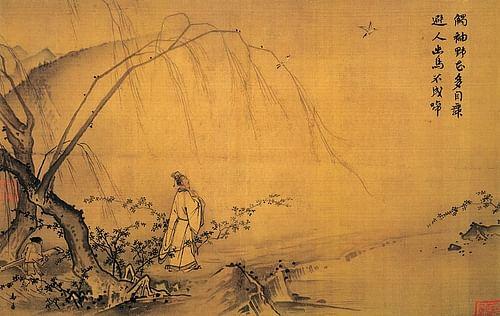Ancient China covered a vast and ever-changing geopolitical landscape, and the art it produced over three millennia is, unsurprisingly, just as varied. Still, despite continuous indigenous technical developments, changes in materials and tastes, and the influence of foreign ideas, there are certain qualities inherent in Chinese art which make it possible to describe in general terms and recognise no matter where or when it was produced and for what purpose. These essential qualities include a love of nature, a belief in the moral and educative capacity of art, an admiration of simplicity, an appreciation of accomplished brushwork, an interest in viewing the subject from various perspectives, and a loyalty to much-used motifs and designs from lotus leaves to dragons. Chinese art would influence tremendously that of its neighbours in East Asia, and the worldwide appreciation of its accomplishments, especially in ceramics, painting, and jade work continue to this day.
The Purpose of Art
An important difference between China and many other ancient cultures is that a large proportion of Chinese artists were not professionals but gentlemen amateurs (and a few ladies) who were also scholars. Students of Confucius and its sober principles, they were often men of literature who published poetry. Art was, for them and their audience, a means to capture and present the philosophical approach to life which they valued. For this reason, the art they produced is often minimal and without artifice, perhaps sometimes even a little austere to western eyes. Art, throughout most of China's history, was meant to express the artist's good character and not merely be an exposition of his practical artistic skills. Such Confucian principles as propriety or li were looked for by many of those who produced and consumed art.
Naturally, there were professional artists too, employed by the Imperial court or wealthy patrons to decorate the walls and interiors of their fine buildings and tombs. Of course, there were, too, thousands of craftsmen working precious materials into objects of art for the few who could afford them, but these were not regarded as artists in the modern sense. The real arts of merit in China were calligraphy and painting. If the art world today is troubled by a certain snobbishness, then the Chinese were perhaps the first to succumb to questions of what is and what is not art.
There grew up in China a connoisseurship of art so that more and more people became collectors of it. Texts were printed to guide people on the history of Chinese art with helpful rankings of the various merits of past artists. In a certain way, art became somewhat standardised with conventions to be adhered to. Artists were expected to study the great masters, copying their works as part of their training. One of the most famous and long-lasting sources of advice on judging art is the six-point list of the 6th century CE art critic and historian Xie He, originally published in his now lost Old Record of the Classifications of Painters. When considering the merits of a painting the viewer should assess the following (with point 1 the most important and essential):
- Spirit Resonance, which means vitality.
- Bone Method, which means using the brush.
- Correspondence to the object, which means depicting the forms.
- Suitability to type, which has to do with laying on of colour.
- Division and planning, that is, placing and arranging.
- Transmission by copying, that is, the copying of models. (Tregear, 94)
These relatively rigid rules of art creation and appreciation were, then, largely due to the belief that art should somehow benefit the viewer. The idea, or better, the acceptance that art could and should express the feelings of the artists themselves would only arrive in more modern times. Still, that is not to say there were not, just as in any art anywhere in the world, eccentrics who ignored the conventions and created works in their own inimitable way. There are cases in China of artists who painted to music not even looking at the picture, one who only painted when drunk and used his cap instead of a brush, those who used their fingers or toes to paint, and even one action artist who splashed ink on the silk spread out on his studio floor and then dragged an assistant over it. Sadly, the results of these innovations have not survived to be enjoyed today in the world's museums of Asiatic art.

Calligraphy
The art of calligraphy - and for the ancient Chinese it certainly was an art - aimed to demonstrate superior control and skill using brush and ink. Calligraphy established itself as one of the major Chinese art forms during the Han dynasty (206 BCE - 220 CE), and for two millennia after, all educated men were expected to be proficient at it. Some women, or at least certain figures at court, did become known as accomplished calligraphers, most notably Lady Wei (272-349 CE), said to have taught the great master Wang Xizhi (303-361 CE).
Far more than mere writing, the art used varying thicknesses of brushstroke, their subtle angles, and their fluid connection to each other - all precisely arranged in imaginary spaces on the page - to create an aesthetically pleasing whole. A connoisseurship quickly developed, and calligraphy became one of the six classic and ancient arts alongside ritual, music, archery, charioteering, and numbers.
The techniques and conventions of writing would influence painting where critics looked for the artist's forceful use of brushstrokes, their spontaneity, and their variation to produce the illusion of depth. Another influence of calligraphy skills on painting was the importance given to composition and the use of blank space. Finally, calligraphy remained so important that it even appeared on paintings to describe and explain what the viewer was seeing, indicate the title (although by no means all paintings were given a title by the original artist) or record the place it was created and the person it was intended for. Eventually, such notes and even poems became an integral part of the overall composition and an inseparable part of the painting itself. There was a fashion, too, for adding more inscriptions by subsequent owners and collectors, even adding extra portions of silk or paper to the original piece to accommodate them. From the 7th century CE owners frequently added their own seal in red ink, for example. Chinese paintings it seems were meant to be perpetually handled and embellished with fine calligraphy.
Painting
Chinese painters painted on various materials in many formats. The most popular formats were on walls (from c. 1100 BCE), coffins and boxes (from c. 800 BCE), screens (from c. 100 CE), silk scrolls which were designed to be looked at in the hand or hung on walls (from c. 100 CE for horizontal and from c. 600 CE for vertical), fixed fans (from c. 1100 CE), book covers (from c. 1100 CE) and folding fans (from c. 1450 CE).
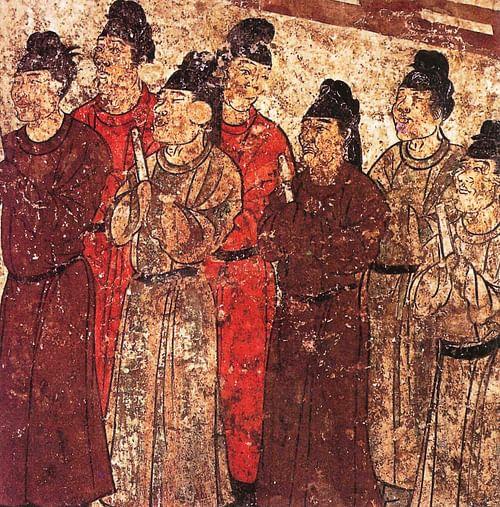
The most popular materials with the earliest artists were wood and bamboo but then the following were adopted: plastered walls (from c. 1200 BCE), silk (from c. 300 BCE), and paper (from c. 100 CE). Canvas would only be used widely from the 8th century CE. Brushes were made from animal hair, cut to a tapering end and tied to a bamboo or wood handle. Significantly, they were precisely the same instruments used by the calligrapher. The inks used were made from rubbing a dried cake of animal or vegetable matter mixed with minerals and glue against a wet stone. Each artist had to laboriously make their own inks as there was no commercial production of them.
The two most popular themes of Chinese painting were portraits and landscapes. Portraits in Chinese art began in the Warring States Period (5th-3rd century BCE) and were traditionally rendered with great restraint, usually because the subject was a great scholar, monk or court official and so should, by definition, have a good moral character which should be portrayed with respect by the artist. For this reason, faces are often seemingly impassive with only the merest hint of emotion or character subtly expressed. Often the character of the subject is much more clearly expressed in their attitude and relationship to other people in the picture; this is especially true of portraits of emperors and Buddhist figures.
There were, however, instances of more realistic portraits and these can be seen particularly in the wall paintings of tombs. A branch of portraiture was to paint historical figures in certain instructive scenes from their life which showed the benefits of moral behaviour. Naturally, there were also paintings of people which had less lofty aims, and these include the popular scenes of Chinese family life which are usually set in a garden.
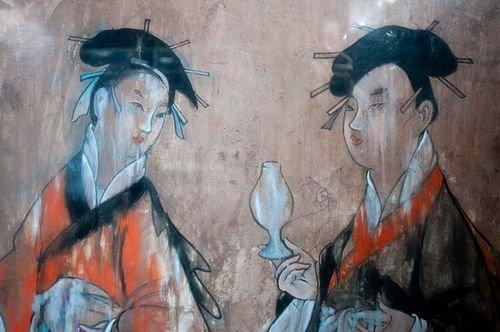
Landscape painting had been around as long as artists had, but the genre really took off during the Tang dynasty when artists became much more concerned with humanity's place in nature. Typically, small human figures guide the viewer through a panoramic landscape of mountains and rivers in Tang paintings. It should be no surprise that mountains and water dominated landscape painting as the very word in Chinese for landscape translates literally as “mountain-and-water”. Trees and rocks are also featured and the whole scene is usually meant to capture a particular season of the year. Colours were limited in use, either everything in various shades of a single colour (illustrating the roots in calligraphy) or two colours combined, usually blues and greens.
In accordance with the Taoist belief in the benefit of contemplating serene nature, there is rarely anything to disturb the tranquillity of landscape paintings such as farm labourers and no specific location is intended to be depicted. Later periods would, though, see more intimate and abstract scenes of nature concentrating on very specific themes such as bamboo gardens. Detailed paintings of a single animal, flower, or bird were especially popular from the Song dynasty (960-1279 CE) onwards, but these were regarded as artistically inferior to the other categories of Chinese painting.
Still, certain animals became symbolic of certain ideas and appeared in paintings just as they had already in other art forms like bronze work. For example, a pair of mandarin ducks denoted a happy marriage, a deer stood for money, and fish for fertility and abundance. Similarly, plants, flowers, and trees had their own meanings. Bamboo grows straight and true like a good scholar should be, the pine and cypress represent endurance, peaches long life, and each season had its own flower: peony, lotus, chrysanthemum, and prunus.
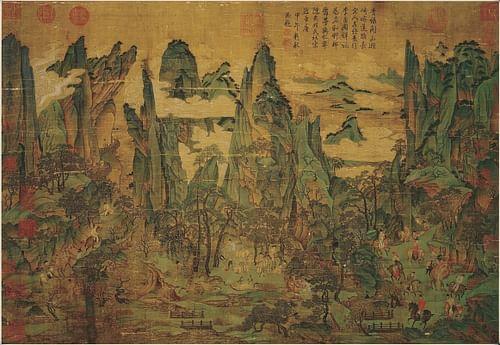
Depth was achieved in paintings by introducing mist or a lake in the middle ground giving the illusion that the mountains are further behind. Other devices include using paler ink and fainter strokes to paint more distant objects while foreground objects are rendered darker and more detailed. Painting the scene with several different viewpoints and multiple perspectives is another common characteristic of Chinese painting. One of the most famous of all Chinese landscape paintings is the 8th century CE painted silk panorama known as 'The Emperor Ming Huang Travelling in Shu'. It is a sprawling and detailed masterpiece of mountain scenery in the typical Tang style using only blues and greens. The original is lost but a later copy can be seen at the Palace Museum of Taipei.
Sculpture
Large-scale figure sculpture has not survived well but some monumental examples can still be seen such as those cut from the rock face at the Longmen Caves, Fengxian temple near Luoyang. Dating to 675 CE the 17.4 metre high figures represent a Buddhist Heavenly King and demon guardians. Another celebrated example of Chinese sculpture on a life-size scale are the figures of Shi Huangti's “Terracotta Army”. Over 7,000 figures of warriors, 600 horses and several chariots were set to guard the tomb of the 3rd-century BCE Qin emperor. Much effort was made to render each figure unique despite them all being made from a limited repertoire of assembled body parts made from moulds. Faces and hair, in particular, were modified to give the illusion of a real army composed of unique individuals.
Regarding smaller-scale works, the Shang Dynasty (c. 1600-1046 BCE) is famous for its cast bronze work. Common shapes of bronze vessels are three-legged cauldrons, sometimes with the legs made into animals, birds, or dragons. They can be circular or square, and many have lids and handles. Sharp relief decoration includes repeating patterns, masks, and scroll motifs. The Shang artists also produced vessels in the form of three-dimensional animals such as rams, elephants, and mythological creatures.
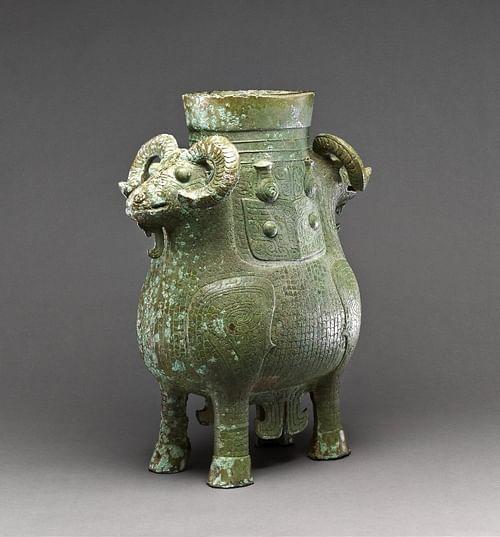
In the Han period, small-scale sculpture took the form of stone or bricks stamped and carved with relief scenes and they are particularly common in tombs. Outstanding examples come from the Wu Liang Shrine at Jiaxiang. Dating to 151 CE or 168 CE, there are some 70 relief slabs which carry scenes of battles and famous historical figures, such as Confucius, all identified by accompanying texts and covering a chronological Chinese history in a pictorial record similar to a history book.
Also in the Han period, cast bronze sculptures of horses were popular. These are usually depicted in full gallop with only one hoof resting on the base so that they almost appear to be flying. Earthenware figurines of single standing women, men, and servants are common from the Han period. Cast bronze was used to make small figurines and ornate incense burners. These were often inlaid with gold and silver or gilded. One superb piece is a gilded bronze oil-lamp in the form of a kneeling servant girl, which dates to the late 2nd century BCE.
While the tombs of emperors and important people sometimes had large figure statues set outside them most later sculpture was of Buddhist subjects. By the time of the Tang dynasty, the wealth of the Buddhist monasteries permitted a great production of religious art. The most popular subjects, as ever, were the Buddha and bodhisattvas, and they ranged from miniature figurines to life-size statues. Unlike in previous periods, figures became much less static, their suggested flowing movement even drawing criticism from some that serious religious figures, on occasion, now looked more like court dancers.
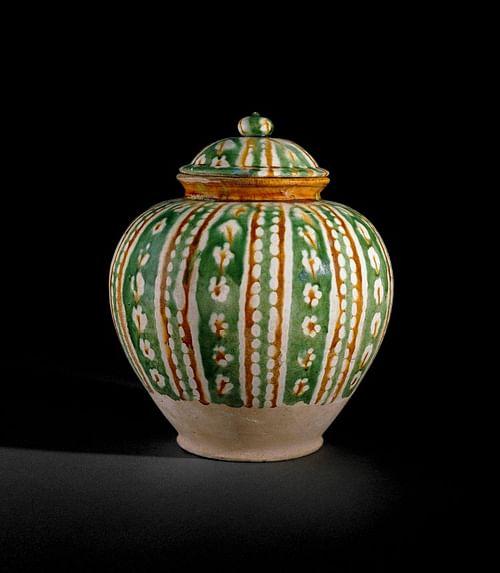
Pottery
The Chinese were the masters of pottery and ceramics. They produced everything from heavy and functional storage jars in earthenware to exquisitely decorated bowls in the most delicate of porcelain, from vases to garden stools, teapots to pillows. They produced the first glaze wares, the first green celadons and the first underglaze wares painted with cobalt blue. Early developments in techniques and kilns led to both higher firing temperatures and the first glazed pottery during the Han period. Pottery, especially the vessels painted with a grey slip commonly found in Han tombs, very often imitated the shape and decoration of bronze vessels, and this would be a goal of many potters in later periods. Clay was used to produce small unglazed models of ordinary houses which were set in tombs to accompany the dead and, presumably, symbolically meet their need for a new home. Many such models are complete with adjacent animal pen and figurines of their occupants and animals.
Tang potters reached a level of technical proficiency greater than any of their predecessors. New colour glazes which were developed in the period included blues, greens, yellows, and browns, which were produced from cobalt, iron, and copper. Colours were mixed, too, producing the three-coloured wares the Tang period has become famous for. Rich inlays of gold and silver were also sometimes used to decorate Tang ceramics. In the Yuan (1271-1368 CE) and Ming (1368-1644 CE) periods even more famous ceramics would be produced with their distinctive and much-copied blue on white decoration which itself copied earlier Chinese paintings for design ideas.
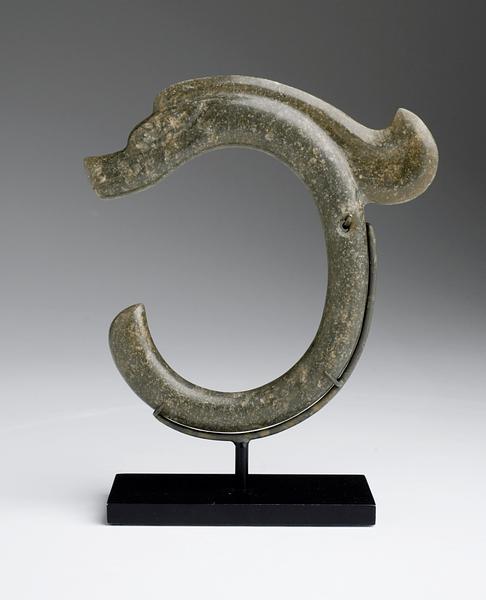
Minor Arts
Gold, silver, copper, bronze, ivory, coloured glass, enamel, precious stones, semi-precious hard stones, silk, wood, and amber were all materials transformed into art objects by gifted craftsmen, but perhaps the most quintessential Chinese materials of the minor arts were jade and lacquer. Jade was especially esteemed in China for its rarity, durability, purity, and association with immortality. Using circular cutting drills and iron tools, the hard material was carved into all manner of jewellery items, everyday objects and figurines of animals, people, and mythical creatures, especially dragons. Jade was especially used for ritual objects such as the bi disc and zong (cong) tubes, both of which were made in large numbers but are of unknown function. One unique but stunning use of jade was the creation of 'suits' to cover the body of the deceased in Han royal tombs. The 'suits' cover the contours of the body and are made from up to two thousand individually carved rectangular pieces of jade stitched together using gold or silver wire.
Lacquer - a liquid of shellac and resin - was used to coat objects of wood and other material since the Neolithic period in China. It was used to colour and beautify screens, furniture, bowls, cups, sculpture, musical instruments, and coffins, where it could be carved, incised, and inlaid to show off scenes from nature, mythology, and literature. The state sponsored and supervised the production of lacquerware, with different schools of lacquer art producing common forms but with recognisably distinct designs. Lacquerware took the form of plates, cups, and jars. Like pottery, they often imitated metal vessels, but they were decorated more elaborately, particularly with scenes of mythical creatures appearing from behind clouds and probably representing the spirit world of the afterlife.
